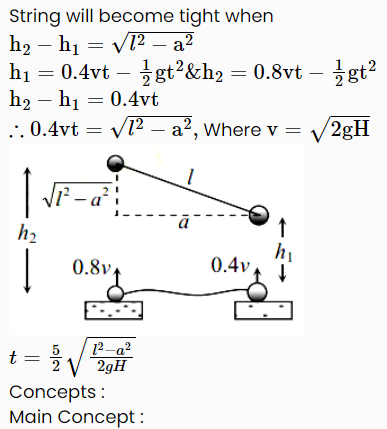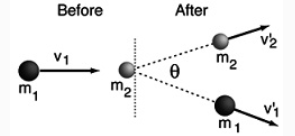
Elastic and Inelastic CollisionsA perfectly elastic collision is defined as one in which there is no loss of kinetic energy in the collision. An inelastic collision is one in which part of the kinetic energy is changed to some other form of energy in the collision. Any macroscopic collision between objects will convert some of the kinetic energy into internal energy and other forms of energy, so no large scale impacts are perfectly elastic. Momentum is conserved in inelastic collisions, but one cannot track the kinetic energy through the collision since some of it is converted to other forms of energy. Collisions in ideal gases approach perfectly elastic collisions, as do scattering interactions of sub-atomic particles which are deflected by the electromagnetic force. Some large-scale interactions like the slingshot type gravitational interactions between satellites and planets are perfectly elastic.
Collisions between hard spheres may be nearly elastic, so it is useful to calculate the limiting case of an elastic collision. The assumption of conservation of momentum as well as the conservation of kinetic energy makes possible the calculation of the final velocities in two-body collisions.

An elastic collision is defined as one in which both conservation of momentum and conservation of kinetic energy are observed. This implies that there is no dissipative force acting during the collision and that all of the kinetic energy of the objects before the collision is still in the form of kinetic energy afterward.
For macroscopic objects which come into contact in a collision, there is always some dissipation and they are never perfectly elastic. Collisions between hard steel balls as in the swinging balls apparatus are nearly elastic.
"Collisions" in which the objects do not touch each other, such as Rutherford scattering or the slingshot orbit of a satellite off a planet, are elastic collisions. In atomic or nuclear scattering, the collisions are typically elastic because the repulsive Coulomb force keeps the particles out of contact with each other.
Collisions in ideal gases are very nearly elastic, and this fact is used in the development of the expressions for gas pressure in a container.
Coefficient of restitution
The coefficient of restitution (COR) is a measure of the "bounciness" of a collision between two objects: how much of the kinetic energy remains for the objects to rebound from one another vs. how much is lost as heat, or work done deforming the objects.
The coefficient, e is defined as the ratio of relative speeds after and before an impact, taken along the line of the impact:
Coefficient of restitution(e) = Relative speed after collision/Relative speed before collision
Hence, the correct option is (A)


 Get latest Exam Updates
Get latest Exam Updates 
 ×
×
















